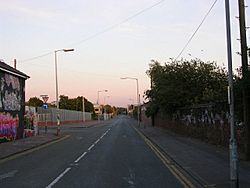Beswick, Manchester facts for kids
Quick facts for kids Beswick |
|
|---|---|
 Gorton Road in Beswick |
|
| OS grid reference | SJ865975 |
| Metropolitan borough | |
| Metropolitan county | |
| Region | |
| Country | England |
| Sovereign state | United Kingdom |
| Post town | MANCHESTER |
| Postcode district | M11 |
| Dialling code | 0161 |
| Police | Greater Manchester |
| Fire | Greater Manchester |
| Ambulance | North West |
| EU Parliament | North West England |
Beswick is a cool area in East Manchester, England. It's right next to a place called Openshaw. Two important things flow through Beswick: the River Medlock and the Ashton Canal. Long ago, Beswick was part of Lancashire.
Contents
A Look Back at Beswick's Past
Around the years 1200 to 1230, this area was known as Bexwic. People think this name came from combining a person's name with a word for a settlement or home.
During the time of the Industrial Revolution, Beswick was mostly a place where people lived. It had many terraced houses, which are rows of homes joined together. There wasn't as much industry here compared to other nearby areas like Bradford.
Beswick and the Commonwealth Games
In 2002, East Manchester, including Beswick, became very important. It hosted the XVII Commonwealth Games! This big event brought lots of new buildings and improvements to the area.
Some of these new places included the City of Manchester Stadium, which is now a famous football ground. There was also the National Cycling Centre, where people can cycle indoors, and the English Institute of Sport. Other new sports places were the National Squash Centre, a Regional Athletics Arena, and an Indoor Tennis Centre. These developments helped make Beswick a modern sports hub.
How Beswick Was Governed
Beswick used to be the largest "township" of the old parish of Manchester. A township was like a small local area with its own rules. It was part of a larger region called Salford Hundred in the county of Lancashire.
In 1838, Beswick became part of the Township of Manchester. It joined with another area called Ardwick to form a "Municipal Ward." This meant they worked together to manage local services. Over time, Beswick continued to be part of how Manchester was organized and managed.
Images for kids





